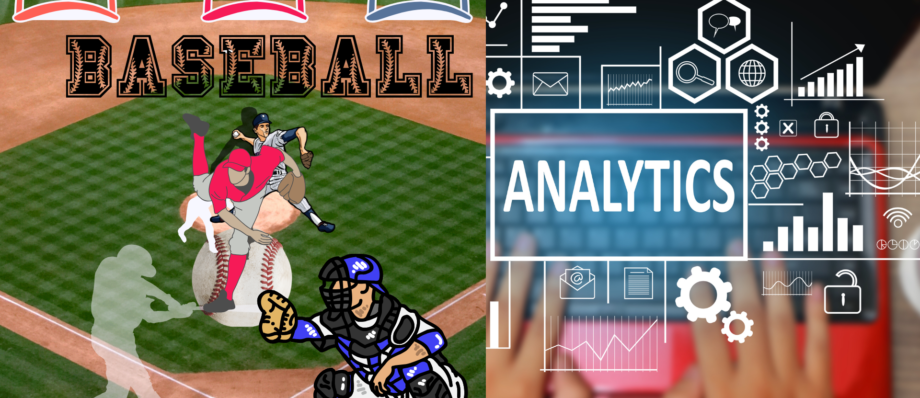🔥7 Key Impacts of Baseball Analytics and Defensive Shifts 🔥
- 01/18/2025
- Baseball, College Recruiting, Sports Pyschology
- 18 mins read

Table of Contents
Toggle✅ How Modern Baseball Analytics and Defensive Shifts Are Squeezing Batting Averages 🚨
Breaking Down the Numbers:
Baseball analytics has changed the game, providing teams with unprecedented insights into player performance, strategies, and probabilities.
One of the most notable impacts of this data-driven approach has been the emergence of defensive shifts, which, combined with increasingly dominant pitching and athletic defenders, have significantly reduced hitters’ ability to find gaps and maintain high batting averages.
This article peeks into the historical rise of baseball analytics; its effects on hitting at the professional, collegiate, and high school levels. We’ll also have a look at other contributing factors that have reshaped offensive production in the modern era.
💻 Early History of Baseball Analytics
Baseball has always been a numbers-driven game. Early statistical tracking in the late 19th and early 20th centuries focused on basic metrics such as batting average, home runs, and runs batted in (RBIs). These traditional stats provided fans and teams with a simple way to measure performance.
In the 1970s, Bill James, often referred to as the father of sabermetrics, introduced a new wave of baseball analytics with his series of “Baseball Abstracts.”
James argued that traditional statistics often misrepresented a player’s true value, advocating instead for advanced metrics such as on-base percentage (OBP) and slugging percentage (SLG). His work laid the foundation for modern analytics by emphasizing efficiency, strategy, and deeper statistical insights.
✅ Baseball Analytics in the Professional Era ✅
By the early 2000s, teams like the Oakland Athletics, under the leadership of General Manager Billy Beane, adopted James’ principles. The “Moneyball” era demonstrated how teams with limited budgets could exploit inefficiencies in the market by prioritizing analytics over traditional scouting methods.
Metrics like Wins Above Replacement (WAR), Weighted Runs Created Plus (wRC+), and Fielding Independent Pitching (FIP) became essential tools for evaluating players.
The rise of Statcast in 2015 marked another leap forward in baseball analytics. Using high-speed cameras and radar, Statcast tracks player movements, pitch trajectories, and batted ball data with unparalleled precision.
Metrics like exit velocity, launch angle, and expected batting average (xBA) gave teams and players deeper insights into performance.
🔥7 Key Impacts of Baseball Analytics and Defensive Shifts 🔥
Reduced Emphasis on Batting Average
Baseball analytics has shifted the focus away from traditional stats like batting average, prioritizing metrics such as OPS (On-Base Plus Slugging) and wRC+ that provide a broader view of offensive contribution. As a result, players with lower batting averages but high power or on-base skills are more valued.
Increased Focus on “Three True Outcomes”
Analytics-driven strategies have led to an increased reliance on home runs, walks, and strikeouts—the so-called “three true outcomes.” This approach minimizes the importance of situational hitting and bunting, reducing the variety of offensive strategies in the game.
🎯Optimization of Defensive Alignments Beyond Shifts
Defensive analytics now optimize alignments for outfield positioning, catcher framing, and even infield depth, reducing the likelihood of extra-base hits or successful bunts. These adjustments further limit offensive opportunities.
Heightened Value of Utility Players
Analytics have underscored the value of versatile defenders who can play multiple positions effectively. Teams increasingly prioritize players who can adapt to various alignments, contributing to the effectiveness of shifts and other defensive strategies.
⬇️Decline of Traditional Leadoff Hitters
The analytics-driven focus on power and on-base percentage has diminished the role of the speed-first leadoff hitter, traditionally responsible for setting the table. Today, leadoff spots often go to players with high OBP and slugging potential, regardless of speed.
Emergence of “Pitching Labs”
Teams are investing in pitching development systems informed by analytics. These “labs” optimize pitch design, spin efficiency, and release point, making it harder for hitters to succeed, even beyond the impacts of defensive shifts.
Impact on Fan Engagement
The reliance on analytics and defensive shifts has sparked debate about the entertainment value of the game. Critics argue that fewer hits, increased strikeouts, and the decline of small-ball tactics make the game less engaging, prompting MLB to implement rules to restore balance.
⏳The Defensive Shift Cycle ⏳
One of the most visible effects of baseball analytics has been the widespread use of defensive shifts. Based on spray charts and predictive models, teams now position fielders where hitters are most likely to hit the ball.
The shift has transformed the dynamics of the game and raised important questions about its implications for offensive strategy and overall entertainment value.
🕰️Timeline of the Shift’s Rise
Pre-2000s: Defensive alignments were mostly traditional, with minor shifts for extreme pull hitters like Ted Williams.
2000s: Teams began experimenting with shifts more frequently, inspired by data-driven studies on hitter tendencies.
2010s: Defensive shifts became commonplace, especially against left-handed power hitters. The Tampa Bay Rays and Houston Astros were early adopters of aggressive shifting.
2020s: By this time, shifts had become the norm. In 2022, MLB introduced a rule limiting defensive shifts starting in the 2023 season to counteract declining league-wide batting averages.
⛓️💥The Effects of Shifts on Hitting
Defensive shifts have made it increasingly difficult for hitters to achieve success. Pull hitters, in particular, have seen sharp declines in their batting averages as infielders stack one side of the field.
Ground balls that once snuck through the right side now routinely turn into outs. For example, Joey Gallo’s batting average dropped precipitously in seasons where he faced the shift over 90% of the time.
In response, some players have attempted to adjust by hitting to the opposite field or focusing on hitting over the shift with increased launch angles.
However, these adjustments come with trade-offs, often leading to higher strikeout rates or reduced consistency. This raises an important question: Are shifts enhancing the game’s strategy or detracting from its overall excitement?
⬇️The Decline in Offensive Production
The combination of defensive shifts, dominant pitching, and elite defenders has made it increasingly difficult for hitters to succeed. Key statistics underscore this trend:
Batting Average: League-wide batting averages have steadily declined, from .269 in 1999 to .243 in 2022, the lowest since the pitcher-dominated 1968 season.
Strikeout Rates: Strikeout rates have risen dramatically, from 16% in the 1990s to over 23% in 2022, as pitchers throw harder and use more advanced pitch designs.
⚾ BABIP(Batting Average on Balls in Play): BABIP has remained relatively stable, but analytics-driven defensive positioning has reduced the number of hits on hard-hit balls.
Other factors contributing to the decline in offensive production include the widespread use of bullpen specialists, optimized pitch sequencing, and the prioritization of power over contact. Each of these elements ties back to the broader influence of analytics on strategy.
⚾Impact on Collegiate and High School Levels⚾
While professional baseball has led the way in adopting analytics, its influence has trickled down to collegiate and high school programs, reshaping the development of players at these levels.
Collegiate Baseball:
Analytics are increasingly used to scout opponents, optimize lineups, and evaluate player development. Programs like Vanderbilt and LSU leverage advanced technology such as TrackMan and Rapsodo to gain a competitive edge.
Defensive shifts are now a common sight in college baseball, forcing hitters to adjust their approach.
The emphasis on measurable skills, such as exit velocity and spin rate, affects player recruitment and training, sometimes at the expense of fundamentals like situational hitting.
High School Baseball:
While high schools have limited access to professional-grade analytics tools, many programs use basic data analysis to position fielders and assess player performance.
The emphasis on launch angle and exit velocity has influenced young hitters to focus on power, often at the expense of contact hitting.
Coaches increasingly educate players on how to counteract shifts, though the lack of professional-level resources often limits their ability to implement comprehensive strategies.
Key Factors Affecting Hitting
Pitching Dominance:
The average fastball velocity in MLB has increased from 90.5 mph in 2002 to 94.3 mph in 2022, making it harder for hitters to adjust.
Pitchers now employ advanced grips and spin rates to maximize the effectiveness of breaking balls and off-speed pitches.
Athletic Defenders:
Today’s defenders are faster, stronger, and more agile than ever. Outfielders cover more ground, and infielders’ improved range has turned many would-be hits into outs.
Analytics have also influenced defensive training, with players optimizing their positioning and first-step reactions.
Hitter Adjustments:
Hitters have responded by adopting new strategies, such as emphasizing launch angle to hit over the shift. However, this approach often leads to higher strikeout rates.
Some players, like Freddie Freeman and DJ LeMahieu, succeed by maintaining a balanced approach focused on all-field hitting.
The Future of Baseball Analytics
Baseball analytics will continue to evolve, influencing every aspect of the game. Emerging technologies such as AI and machine learning promise even greater insights into player performance and strategy.
However, as defensive shifts, pitching dominance, and other analytic-driven strategies continue to challenge hitters, one critical question remains: How can baseball maintain a balance between strategy and entertainment?
Conclusion
The rise of baseball analytics has fundamentally altered the game, making it harder for hitters to succeed. Defensive shifts, advanced pitching, and elite defenders have collectively reduced offensive production across all levels of play. The introduction of rules limiting shifts may restore some balance, but the era of analytics-driven baseball is here to stay.
EliteCoachingandTraining Newsletter
Signup for college recruiting news and high school sports information
Thank you!
You have successfully joined our subscriber list.



